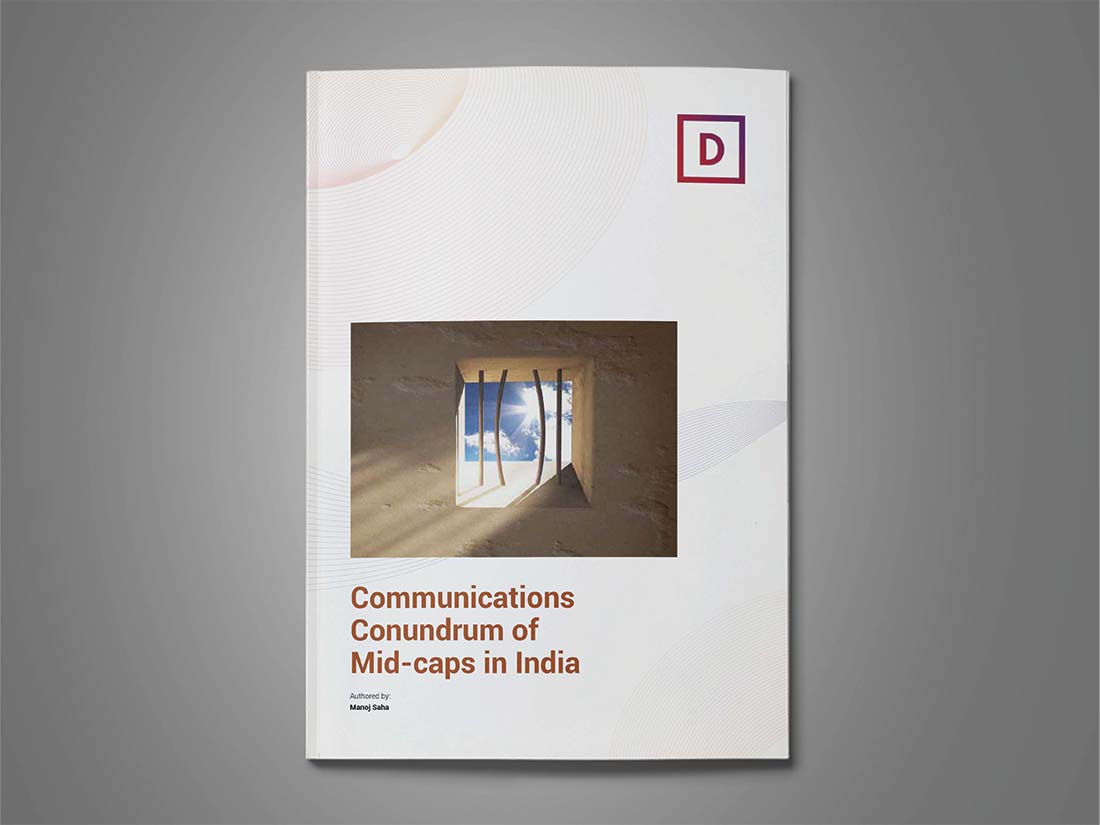Communications Conundrum of Mid-caps in India
If sustained media visibility is critical for enhancing corporate reputation; then nothing is more daunting for mid-cap companies than to achieve that. It is an ongoing struggle for the mid-cap companies. Their sheer number – more than 1500 actively traded mid-caps – and limited avenues to showcase themselves intensify their travails. Seeking external help from PR consultants mostly doesn’t work due to PR agencies’ lack of imagination and the old-school approach. These factors constrain mid-cap companies’ efforts to gain appreciation and endorsement from a wider stakeholder groups. The team at Dickenson Financial PR explore what ails the PR efforts of the mid-caps and look for definitive solution to this muddled state of affairs.
Evolution of Mid-caps
Ever since the concept of a “Joint Stock Company” came into play, companies have been routinely categorised and re-categorised. As India saw the emergence of its first stock exchange – initially in 1855 under a Banyan Tree opposite Town Hall in Mumbai, to a more formal venue in 1875 at Dalal Street – the Bombay Stock Exchange has seen companies getting clubbed under different parameters. From the “carry forward” stocks and the “Cash” stocks, as they were known during an open outcry trading system, to A, B1, B2 and Z categories post digitisation of the exchanges – traders have effortlessly juggled around them. With the globalisation of the Indian economy and the entry of foreign investors, all this changed forever. Now listed stocks are popularly categorised as large caps, mid-caps and small caps.
Such categorisation has a major bearing on companies’ ability to showcase themselves and the opportunities they have at their disposal for stakeholder engagement. While large-cap companies are always on the radar of the wider audiences thanks to the attention they get from the media, it is the mid-cap and small-cap companies that find themselves struggling to get noticed. Take example of The BSE itself – the oldest witness to the stock classifications, recently saw itself getting categorised as a mid-cap stock following its IPO. With the market capitalisation of just about Rs. 5000 crore, The BSE now is just another mid-cap stock, and will get the media attention and the treatment as such.
WHEN IN DOUBT, HIRE A PR AGENCY
Given that advertising can get prohibitively expensive, to overcome the media’s attention deficit, many mid-cap companies resort to the traditional outreach option – public relations – and hire a Public Relations (PR) agency. The process of hiring a PR agency across mid-cap companies is pretty much standard. Start with a laundry list of tasks and deliverables, shoot out RFPs to 3 or more PR agencies, go through the rituals of long power point presentations full of tactical ideas, shortlist two agencies, ask for a quote, haggle and hire an agency based on no compelling but the most sensible reason – the lowest quote for a retainer fee; and a hand shake promise by the agency owner to put more hands and legs on the job.
To be sure, most PR agencies have well cultivated media contacts, many have a National reach that compares with India Post’s reach, a hoard of hard-working and well-meaning PR grads and a marquee client list. Now such credentials are sure to impress a CEO or a CFO of a mid-size company looking for its place in the sun.
are you being served?
Mid-cap companies would do better by knowing that the most PR agencies charge fee for inputs while outputs and outcomes are rarely articulated. A mid-cap client, from an agency’s point of view, gets commensurate man-hours in return for the fee it pays. The quality and the quantum of media exposure is usually on best efforts basis. As incremental reputation is almost impossible to quantify, the RoI is never discussed and PR efforts are usually measured by antiquated parameters such as column-centimetre or Share of Voice.
In their arrangement with the PR agency, while the management is media trained, they are never made aware of the editorial compulsions. Press releases issued by mid-caps rarely make it to editorial pages, and even when they do, it usually appears in the “News in Brief” section where the context is often missing. Even as the CEOs / CFOs prepare to be at their best for the business channel interview, they often come out miffed at the quality of the interaction and how little time was given to make any meaningful point. What most mid-caps end up getting is sporadic brief exposure in print and a few minutes of airtime on a quarterly basis. This best effort business by PR agencies continues to play in a loop as mid-cap companies struggle to achieve their seemingly simple and realistic PR objectives.
This situation typically ends with the mid-cap company experimenting with many PR agencies and eventually settling down with the least ineffective one, or stops working with the PR agencies altogether.
institutional IR program does not build public profile
Many mid-cap companies focus their communications efforts on the discerning investors. Unlike PR, IR programs are quite precise in terms of who to communicate, how to communicate, when to communicate and what to communicate. While some companies manage IR function internally with regular support from the investment banks; many companies retain the services of specialised Investor Relations consulting firms.
Embarking on a scientific IR program surely helps well-performing mid-caps in shareholder value creation. However, the rise in market capitalisation is just one of the pillars on which corporate reputation rests. As we all know, it’s not rare to find companies with a track record of value creation, having questionable governance or environmental practices.
The communications techniques employed in an IR program are well templatised. The quarterly presentations are usually limited to rationalising the current performance, and the earnings calls are more about microanalysis and nit-picking. This specific communication program targeted towards a focused group of analysts and investors does not build a mid-cap company’s public profile. The limited scope of IR programs miss out on larger corporate narratives by focusing too much on the financial performance.
the big question
Well performing Mid-cap companies have many stories to tell. These stories are not limited to material corporate developments or quarterly reported numbers.
These stories are about a) operational excellence; b) improving efficiencies achieved through years of meticulous planning, c) innovative marketing strategies or could be about long term value drivers that would help a small / mid cap eventually become a large-cap company. These well-articulated stories, when find their way to the relevant audiences, can make a world of difference to how companies will be perceived by not just the investors, but also lenders, business partners, policy makers, prospective employees and by the media.
The question is – is there a way to level the field in favour of mid-caps? Can mid-caps have opportunity to get their unadulterated, undiluted and bias-free stories out? Can there be a PR program for mid-caps that is research driven, proactive, objective oriented and measurable? Is there a way in which mid-caps’ reputation management efforts can be made more sustainable?
A goal oriented, measurable Financial PR campaign for mid-caps
At Dickenson, we were seized with this idea and have designed a Financial Public Relations program that overcomes most of the conundrums narrated so far.
In our efforts to design the most optimal, cost effective Financial PR delivery model, we realised that mid-cap companies’ requirements are quite specific, and they do not need a bouquet of services that a large company may need. Neither do they need 10 people team nor a network of nation-wide offices.
Dickenson’s Financial PR offering is devoid of all these trappings. It is unique in a way that it marries the best of Corporate Communications and Investor Relations functions. While the program has the rigour that requires for IR, it has a wider appeal of PR. The team that is responsible to design and carry out your Financial PR campaign comes from the Finance background with decades of experience in Capital Market Communications, former business journalists and corporate communications professionals with years of experience in Corporate Reporting.
To know more our differentiated Financial Public Relations delivery model, please write to Manoj Saha, MD, Financial PR on manoj.saha@dickensonworld.com.

Communications Conundrum of Mid-caps in India
To download and save this article.
Authored by:


Leave A Comment